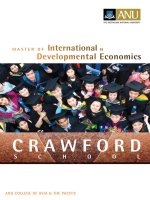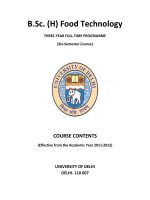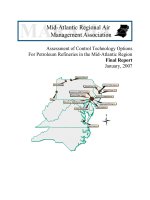“Consumer Perceptions of Food Technology & Sustainability” pptx
Bạn đang xem bản rút gọn của tài liệu. Xem và tải ngay bản đầy đủ của tài liệu tại đây (4.37 MB, 53 trang )
Welcome to the
International Food Information Council
“Consumer Perceptions of
Food Technology & Sustainability”
Webcast for Food and Health Professionals
Thursday, May 10, 2012
2:00 – 3:30 pm EDT
Please dial in to the audio
portion of the Webcast:
Dial-in #: (800) 658-3095
Access code:964856914 #
International Food Information Council
2012
Consumer Perceptions
of Food Technology
Survey
15
th
Edition
Welcome
Marianne Smith Edge,
MS, RD, LD, FADA
Senior Vice President,
Nutrition and Food Safety,
International Food Information Council
International Food Information Council (IFIC)
and The Foundation
Mission: To effectively communicate science-based
information on food safety and nutrition issues to
health professionals, journalists, educators and
government officials.
Mission: To effectively communicate science-based
information on health, nutrition, and food safety for the
public good.
Primarily supported by the broad-based food, beverage,
and agricultural industries.
Today’s Speakers
• Lindsey Loving
Senior Director,
Food Ingredient &
Technology Communications,
International Food Information Council
• Sarah Romotsky, RD
Manager,
Food Ingredients & Technology,
International Food Information Council
How to Submit a Question
• Email with questions
or post questions on Twitter @FoodInsight
• Send questions throughout webcast- we will
answer all questions at the end
• Follow us on Twitter and on Facebook!
Today’s Presentation
• Learning objectives
• Presentation of key findings from
IFIC Food Technology Survey
– Sustainability
– Confidence in Safety & Labeling
– Plant & Animal Biotechnology
• Communication insights for food and
health professionals
• Question and Answer Session
Webcast Objectives
1. Communicate the key takeaways and trends
from the 2012 IFIC Survey regarding consumer
perceptions of food technology and
sustainability.
2. Identify gaps in awareness and opportunities
for communication with consumers regarding
food technology and sustainability issues.
3. Apply understanding of consumer perceptions
in communications with consumers about
food technology to build awareness and
understanding.
Objectives and Methodology
10
Survey Objectives
The purpose of this survey is to:
– Track awareness and perceptions of food
technology
– Reveal concerns, gaps in information, etc.
related to food biotechnology and
new/emerging technologies
– Measure the extent to which consumers’ views
of food technology change over time
– Identify benefits of food biotechnology that
resonate with consumers
This study was conducted annually from 1997 to 2007 (with the exception of 1998,
when no survey was conducted, and in 1999 and 2001, when two surveys were
conducted per year) and has been conducted every other year since 2008.
METHODOLOGY
2012 2010 2008
Population: U.S. adults (18+) U.S. adults (18+) U.S. adults (18+)
Methodology: 100% web 100% web 100% web
Data collection
period:
March 7-19 April 5 – 26 July 29 – August 18
Sample Size (error): n= 750
(+3.58 pp)
n=750
(+3.6 pp)
n=1,000
(+3.1 pp)
Weighting: Data weighted on
gender,
age, race, education,
marital status,
region, and income
to be nationally
representative
Data weighted on gender,
age, race, education, marital status, and
region to be nationally representative
* Research conducted by Cogent Research of Cambridge, Massachusetts
*Use of the term significant throughout the report refers to the statistical significance – meaning we are
95% confident that the change indicated in the sample exists in the total universe.
Sustainability
Awareness of Sustainable
Food Production
Nothing
At All
50%
A Little
23%
Some
20%
Q41 How much have you read or heard about the concept of sustainable food production?
2010
A Lot 7%
Some
22%
A Little
24%
Nothing
At All
44%
2012
A Lot 9%
‘10
Change in Purchasing of
Sustainable Products
2012
Neither
42%
Increased
18%
Do not know
32%
Decreased
7%
Q41B. In the past year, how, if at all, have you changed your purchasing of food and beverage products
that fit your definition of sustainability?
Willingness to Pay More for
“Sustainable” Products
2012
No
31%
Yes
33%
Do not know
37%
Q41C. Are you willing to pay more for food and beverage products that fit your definition of
sustainability?
Importance That Foods are
Produced in a Sustainable Way
Q41D. How important is it to you that the food products your purchase or consume are produced in a
sustainable way?
Important
69%
Neutral
25%
Not
Important
6%
2012
19%
13%
14%
12%
13%
8%
7%
5%
3%
4%
16%
19%
16%
12%
10%
7%
9%
6%
4%
4%
Selected first Selected second
Produce more food with less use of
natural resources
Conserving the natural habitat
Ensuring a sufficient food supply
Reducing the amount of pesticides
Less food and energy waste
Q42A. Please rank the following aspects of “sustainability” in order of importance to you.
2012
Percent that ranked each aspect first or second:
Importance of Aspects
of Sustainability
Ensuring an affordable food supply
Fewer food miles
Reduced packaging material
Lower carbon footprints
Recyclable packaging
26%
13%
25%
15%
11%
6%
4%
3%
6%
11%
12%
12%
30%
25%
1%
0%
Selected first Selected second
Scientists
Farmers/ranchers
Food product manufacturers
Government
Consumers
Q42B With the population estimated to grow to more than 9 billion people by 2050, there will be significant demand
placed on our agriculture system to produce more food more efficiently. Who do you believe is primarily responsible
for ensuring continued access to a safe, affordable, abundant food supply? Please rank in order of responsibility.
2012
Percent that ranked each aspect first or second:
Responsibility to Meet Increased
Food Demand
Other
Grocery stores and other food
retailers
Restaurants
Food Safety
Very confident
Not at all confident
Somewhat confident
Not very confident
Q11. How confident are you about the safety of the US food supply? Would you say…?
Confidence in the Food Supply
Neutral
51% 51%
50%
18%
18%
18%
9%
10% 10%
2%
1%
Confident
Not confident
2010
2012
2008
21%
20% 19%
3%
21
Q12. What, if anything, are you concerned about when it comes to food safety? [OPEN END]
Percent concerned with each food safety issue (unaided):
2012 2010
Disease/contamination
29%
29%
Handling/preparation
21%
23%
Preservatives/Chemicals
13%*
8%
Health/nutrition
8%
7%
Agricultural production
7%
6%
Food sources
7%
8%
Packaging/labeling
5%
4%
Biotech
2%
2%
Processed foods
1%
1%
Other
1%
1%
Food Safety Concerns
* Denotes
statistical
significance
from 2010
22
Q7. Thinking about your diet over the past few months, are there any foods or ingredients
that you have avoided or eaten less of?
Americans Avoiding Certain Foods
Avoidance of foods remains unchanged
among consumers.
23
52%
26%
22%
17%
17%
3%
12%
4%
2%
0%
3%
Sugar/carbs
Sugars
Carbs
Fats/oils/cholesterol
Animal products
Salt/sodium
Snack foods/fast foods/soda
Artificial/additives
Other
Processed/refined foods
Spices
Biotech
Don't Know/ Refused
Category n=400
Subcategory
43%
29%
Q 8. [IF AVOIDED FOODS] What foods or ingredients have you avoided? [OPEN END]
Biotech foods do not make the list of items
Americans are avoiding.
Types of Food Avoiding
Food Labeling
24%
18%
14%
16%
76%
82%
86%
84%
25
Q9. Can you think of any information that is not currently included on food labels that you would like
to see on food labels?
Q 10. [IF YES] What types of information would that be? [OPEN END]
*Those who said "Nothing" or "Don’t know" to Q10 were recoded as "No" answers in Q2.
Interest in Adding Information to
Current Food Labels
Yes
No
2010 2008 2007
2012
‘10
Most Americans do not wish to see any
additional information on food labels
‘12
‘12
‘12









